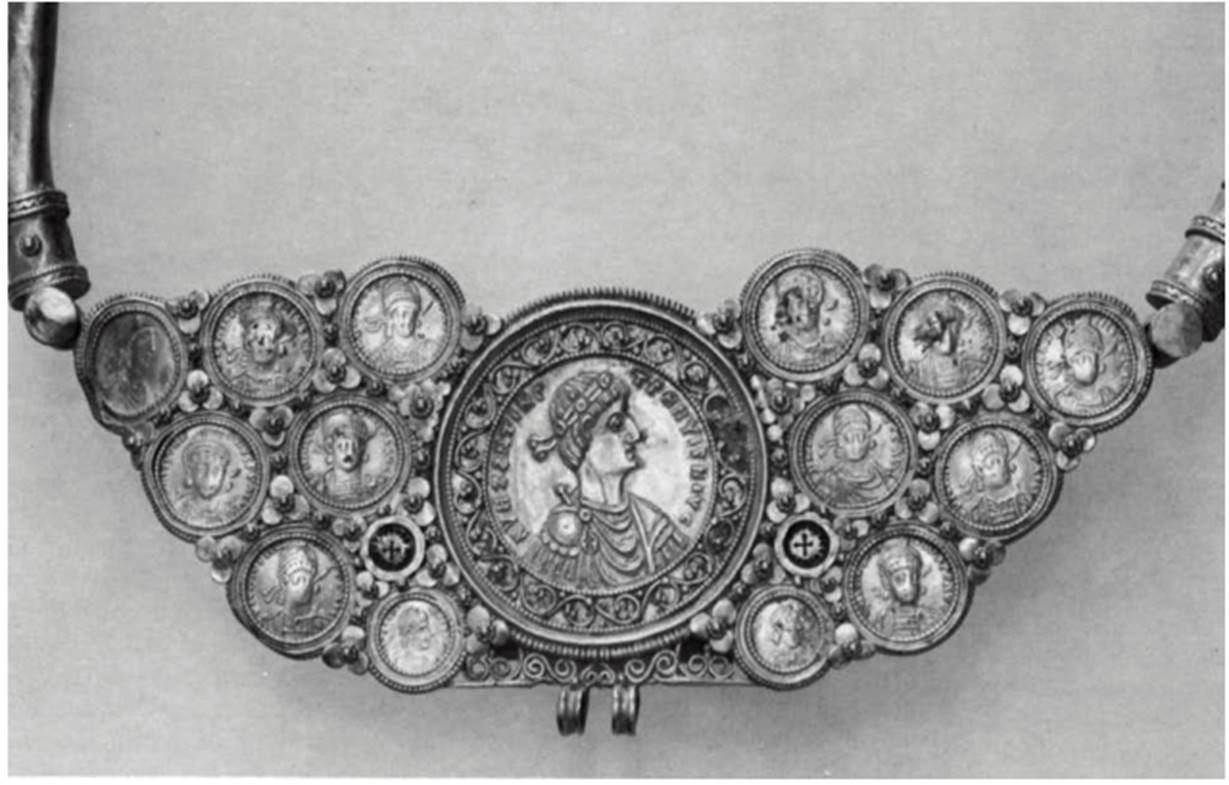Pectoral. Constantinople (?), mid-6th century. Gold and niello
The pectoral is composed of a plain, hollow neckring attached to a frame set with a large central medallion flanked by coins and two small decorative gold and niello discs. The neck-ring is attached to the frame by a screw pin on the left and a hinge on the right. Soldered to the lower edge of the pectoral are two ribbed rings—from which, originally, hung the medallion of Theodosius I, now in the Freer Gallery, Washington, D.C.
The pectoral is part of the treasure said to have been found either at Апйпоё or in Tomei, near Assiut. Even though these objects were found in Egypt, it is now thought that they were made in Constantinople. For discussion of this attribution, see no. 284.

The coins represent various emperors reigning during the fourth to sixth century, who, for the most part, are portrayed in military dress. The latest coins date from the reign of Justinian.
The central medallion shows, on the obverse, an emperor in military attire and, on the reverse, the figure of Constantinopolis, seated on a high- backed throne and wearing a helmet and tunic. She holds a globus cruciger and a scepter, and her left foot rests on the prow of a ship. This image reflects the passing of political primacy from Rome to Constantinople. The essentially unintelligible inscription is nearly identical on both faces of the medallion.
Scholarly opinions have varied concerning the workmanship of this medallion. Dennison (1918, p. 110) thought it was a barbaric imitation of a Byzantine model based on a coin of Valentinian III. J. P. C. Kent (Kent to K. R. B., 1970) has suggested that the inscription might be read as an attempt at D(ominus) N(oster) ivstini-anvs p(er)p(etuus) AVG(ustus) and that the medallion might be the work of a Langobardic goldsmith. This suggestion is chronologically tenable, since the latest coins are Justinianic. On the basis of a stylistically similar medallion of Justin I (Browning, 1971, end of the preface), Ross (verbally) proposed that the medallion is of Byzantine workmanship.
Each coin, as well as the medallion, is surrounded by beaded wire, with small rosettes and larger trefoils, and central rosettes in the interstices. Whereas the medallion, which is in pristine condition, was probably made especially for the pectoral in the sixth century, the neck-ring and coins show considerable wear—indicating that they had an earlier, independent history.
A sixth-century source tells us that Justinian's great general Belisarius recompensed his soldiers with large gifts of money and honored them with bracelets and necklaces (Procopius De bello Gothico 1. 1. 8). Earlier sources report that both neck-rings and coins played a role in coronation ceremonies. Consequently, there can be little doubt that this pectoral represents a collection of military trophies, which belonged to a distinguished general, if not to an emperor.
Formerly in the J. Pierpont Morgan collection. Bibliography: Zahn, 1916, cols. 44 ff.; Dennison, 1918, nos. 1, 2; Peirce and Tyler, 1934, II, p. 139; Ross, 1965, II, nos. 11, 46; Brown, 1970.
Date added: 2025-08-31; views: 84;
